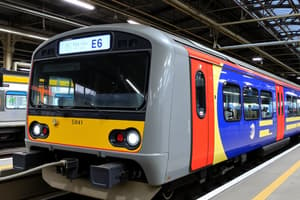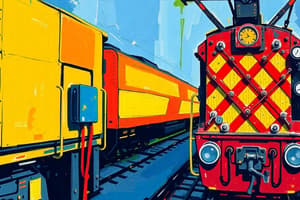Podcast
Questions and Answers
When should the independent brake valve be applied?
When should the independent brake valve be applied?
- Immediately upon leaving the engine house.
- While passing the main line switch.
- After the train has stopped at the station. (correct)
- When the train reaches maximum speed.
How should engineers signal the start of the ride to the conductor?
How should engineers signal the start of the ride to the conductor?
- Give a visual 'High Ball' signal. (correct)
- Use a loud whistle.
- Contact the conductor via radio.
- Tap on the engineer's window.
What is the correct procedure for stopping the train at the station?
What is the correct procedure for stopping the train at the station?
- Accelerate until the cow catcher reaches the orange RR tie.
- Gradually apply the independent brake valve.
- Immediately cease all engine operations.
- Use the automatic brake valve to stop the train. (correct)
What is one of the responsibilities of the engineer during operation?
What is one of the responsibilities of the engineer during operation?
What should be monitored while proceeding slowly around the track?
What should be monitored while proceeding slowly around the track?
Which component must be opened slightly after stopping the train?
Which component must be opened slightly after stopping the train?
What should engineers and firemen do before moving the train out of the station?
What should engineers and firemen do before moving the train out of the station?
Which of the following signals indicates an approaching crossing?
Which of the following signals indicates an approaching crossing?
What is a key responsibility of the Third Engineer?
What is a key responsibility of the Third Engineer?
How should the train approach the turn behind the car shed?
How should the train approach the turn behind the car shed?
What is the primary purpose of good communication between engineers and conductors?
What is the primary purpose of good communication between engineers and conductors?
What should be checked during the visual inspection before departing the station?
What should be checked during the visual inspection before departing the station?
What is essential to avoid when pulling out of the station?
What is essential to avoid when pulling out of the station?
During which circumstances should the Engineer assist the Third Engineer?
During which circumstances should the Engineer assist the Third Engineer?
What must be done first before backing the train?
What must be done first before backing the train?
What does a red signal on the main line switch lamp indicate?
What does a red signal on the main line switch lamp indicate?
When riding the train through the engine house, what is advised?
When riding the train through the engine house, what is advised?
What should be done when approaching the next switch and seeing a green lamp?
What should be done when approaching the next switch and seeing a green lamp?
Who takes over the duties of the third engineer if they are unavailable during the last run of the night?
Who takes over the duties of the third engineer if they are unavailable during the last run of the night?
What action should be taken with the switch lamp before the last run of the night?
What action should be taken with the switch lamp before the last run of the night?
How should the engineer be notified to commence backing up the train?
How should the engineer be notified to commence backing up the train?
What is the appropriate response if someone is found on the track during the backing process?
What is the appropriate response if someone is found on the track during the backing process?
Flashcards are hidden until you start studying
Study Notes
Train Operation Procedures
- Change the switch to the main track after the train passes the main line switch (I-10).
- Apply graphokote to the track as needed during the test run.
- Monitor track conditions for debris or obstructions while moving slowly; listen for unusual sounds.
- Use the automatic brake valve (D-16) to stop the train with the cow catcher positioned between the orange RR tie and the yellow arrow on the salt shed.
Engineer Responsibilities
- Monitor track for debris and obstructions.
- Periodically check the water level in the boiler, ensuring the engine is level.
- Ensure all passengers are seated before starting the engine.
- Keep the engine fueled with propane and water.
- Observe switch track signals for proper alignment on each run.
- Grease and oil the train every two hours during operation.
- Conduct periodic safety checks on the engine and sound the whistle at start and crossings.
Fireman Duties
- Regulate fire to maintain appropriate steam levels and ensure water is sufficient in the boiler.
- Add water or fuel to storage tanks as necessary.
- Watch the opposite side of the track for hazards.
- Respond to the conductor's "High Ball" signal indicating departure readiness.
- Ensure safety of guests during train startup.
- Check levels of fuel and water periodically and assist the engineer.
Third Engineer Responsibilities
- Follow tasks assigned on the Task Sheet in the engine house.
- Assist both the engineer and fireman as needed.
- Help with opening or closing procedures.
General Operations Communication
- Maintain clear communication between engineers and conductors who regulate guest boarding and unloading.
- Conduct a final visual check prior to departure after "high ball" signal.
- Sound two short whistle blasts before leaving the station and slowly increase speed.
Warning Signals at Crossings
- Signal crossings with two long whistle blasts followed by one short and one long blast.
- Specific crossings requiring signals include White Water Canyon and the service road under the Soak City pedestrian bridge.
Backing and Switching Procedures
- Fill the tender with water prior to backing; ensure all coaches are empty of guests.
- Signal the engineer with a flashlight to initiate backing, and monitor tracks for safety.
- Change the main line switch and confirm the proper signal before proceeding with the backup.
- Identify the correct side for the engine house based on the switch lamp color.
Final Duties in the Engine House
- Ensure the path is clear for the train in the engine house during the last run of the night.
- Signal the engineer during the backing procedure to ensure all is clear.
- Uncouple the tender from the coaches as needed, with attention to safety protocols.
Studying That Suits You
Use AI to generate personalized quizzes and flashcards to suit your learning preferences.




